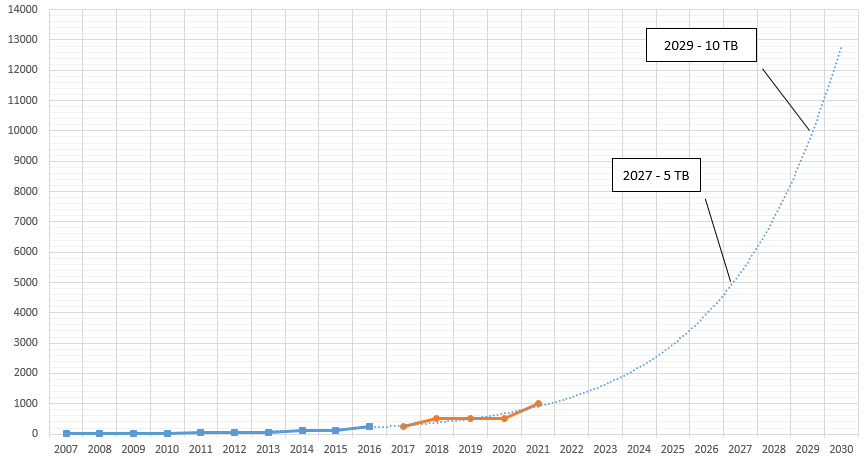While I’m no fan of Apple, the iPhone has so far been the leader in performance and storage. The internal storage of Apple’s latest and greatest iPhone provides a good benchmark for the current level of storage of the entire smartphone industry. When an iPhone with a new level of storage comes out, every manufacturer plays catch-up with Apple releases a flagship phone of similar storage.
Here is a chart that shows the trend in iPhone in internal storage. It extrapolates the trend into the future to predict when the iPhone will likely have one terabyte of internal storage (blue is historical storage levels, orange is predicted, and the dotted line is the trendline):
 The chart assumes an exponential trend, since storage density and prices have followed an exponential increase and reduction trend.
The chart assumes an exponential trend, since storage density and prices have followed an exponential increase and reduction trend.
I assumed that from 2018 through 2020, the iPhone will stay at 512 GB, similar to how it remained at 64 GB from 2011 through 2013. It is possible that instead of this, the iPhone will stay at 256 GB from 2017 through 2019. This will not significantly affect the historical trend.
Here is the same chart with the forecast extended to 2030. The trendline predicts an internal storage of 5 terabytes in 2027 and 10 terabytes in 2029.
 I know that 10 terabytes in a smartphone may seem unnecessarily high. But historical trends show that every age can find good (and frivolous) uses for all the storage it can get.
I know that 10 terabytes in a smartphone may seem unnecessarily high. But historical trends show that every age can find good (and frivolous) uses for all the storage it can get.
Below is a table of every iPhone release date, device name, highest offered storage and battery capacity:
| Release Date |
Device | Storage (GB) |
Battery (mAh) |
| June 29, 2007 | iPhone 1 | 16 | 1400 |
| July 11, 2008 | iPhone 3G | 16 | 1150 |
| June 19 2009 | iPhone 3GS | 32 | 1219 |
| June 24, 2010 | iPhone 4 | 32 | 1420 |
| October 14, 2011 | iPhone 4S | 64 | 1432 |
| September 21, 2012 | iPhone 5 | 64 | 1440 |
| September 20, 2013 | iPhone 5S | 64 | 1560 |
| September 19, 2014 | iPhone 6 | 128 | 1810 |
| September 25, 2015 | iPhone 6S | 128 | 1715 |
| September 16, 2016 | iPhone 7 | 256 | 1960 |